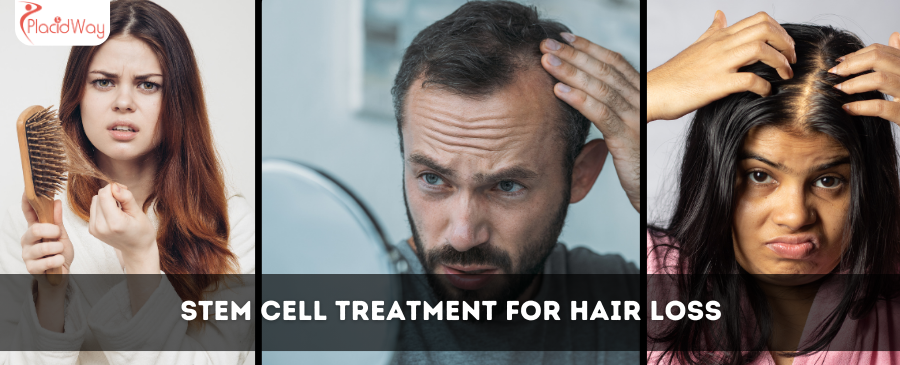
Watching your hair thin over time can be a frustrating experience, affecting confidence and making you feel older than you are. For decades, the primary solutions were limited to topical creams, medications with potential side effects, or invasive surgical procedures. But what if you could tap into your body's own healing power to regrow your hair? This is the promise of stem cell treatment for hair loss, a groundbreaking approach in the field of regenerative medicine that is changing the way we think about hair restoration. It’s not about covering up the problem, but about waking up your hair follicles at a cellular level.
The science behind it is both elegant and powerful. Deep within your skin and fat tissues are dormant stem cells—master cells with the unique ability to transform into other cell types and signal a repair response. By harvesting these cells and reintroducing them to your scalp, the treatment kickstarts a regenerative process. These stem cells help to rejuvenate damaged or dormant hair follicles, pushing them from a resting phase back into an active growth phase. If you're searching for a modern, minimally invasive solution to combat hair thinning and restore a fuller head of hair, understanding how stem cell therapy works is the first step toward reclaiming your confidence. This guide will answer all your pressing questions about this innovative treatment.
What exactly is stem cell treatment for hair loss?
Think of your hair follicles as tiny engines that produce hair. Over time, due to genetics, age, or hormonal changes, these engines can stall or shut down. Stem cell treatment for hair loss is like sending a specialized repair crew to restart them. The treatment leverages the power of Mesenchymal Stem Cells (MSCs), which are known for their powerful regenerative abilities.
Unlike traditional hair transplants that move follicles from one place to another, stem cell therapy aims to revive the follicles you already have. The injected stem cells release growth factors and signaling proteins that reduce inflammation, improve blood flow, and provide the building blocks for follicular repair. This creates a healthier environment on the scalp, making it possible for dormant follicles to re-enter the anagen (growth) phase of the hair cycle.
How does stem cell therapy work to regrow hair?
The mechanism behind stem cell hair restoration is a multifaceted biological process. Once injected into the scalp's subcutaneous layer, the stem cells don't just magically turn into new hair follicles. Instead, they act as powerful signaling agents that orchestrate a complex healing and regeneration cascade.
Key actions include:
- Activating Follicular Stem Cells: Your hair follicles already have their own population of stem cells. The injected MSCs "wake up" these resident cells, encouraging them to divide and create new hair shafts.
- Angiogenesis: They promote the formation of new blood vessels around the follicles. This increased blood supply delivers more oxygen and essential nutrients needed for robust hair growth.
- Anti-inflammatory Effects: Chronic inflammation is a known contributor to hair loss. Stem cells release anti-inflammatory agents that calm the scalp environment, protecting follicles from further damage.
- Prolonging the Anagen Phase: By providing continuous regenerative signals, stem cells help to extend the active growth phase of the hair cycle, leading to longer and thicker hair strands.
How much does stem cell treatment for hair loss cost?
The investment in stem cell hair treatment varies significantly across the globe. Since it is considered a cosmetic and elective procedure, it is not covered by insurance. The final cost is determined by factors such as the reputation of the clinic, the expertise of the doctor, and the specific protocol being used. Some clinics may recommend multiple sessions for optimal results, which would increase the total investment.
To provide a clearer picture, here’s a comparison of estimated costs in different regions for a single comprehensive treatment session.
| Country/Region | Estimated Cost Range (USD) | Primary Factors |
|---|---|---|
| United States | $6,000 - $12,000+ | High overhead, stringent regulations. |
| United Kingdom | $5,000 - $10,000 | Competitive market, but high operational costs. |
| Mexico | $4,000 - $8,000 | Popular medical tourism hub, lower overhead. |
| Turkey | $3,000 - $7,000 | Extremely competitive pricing for cosmetic procedures. |
Is stem cell therapy for hair loss safe?
Safety is a primary advantage of autologous stem cell therapy. The procedure uses your biological material, which the body recognizes as its own, eliminating the possibility of an adverse immune response. The entire process—from harvesting the fat to processing the cells and injecting them—is typically performed in a single session within a sterile clinical environment to minimize any risk of contamination.
The key to a safe procedure is selecting a credible and experienced clinic. You should ensure the doctor is a specialist in regenerative medicine and that the clinic follows strict protocols for cell handling and processing. Avoid any clinics that use stem cells from unverified sources (e.g., donor umbilical cords or animal products) for hair loss, as these are not standard practice and can pose health risks.
Who is a good candidate for this treatment?
Stem cell treatment for hair loss is not a miracle cure for completely bald areas where follicles have died off entirely. Its strength lies in reviving weakened follicles and thickening existing hair. You are likely a good candidate if:
- You have noticed significant hair thinning, but still have hair coverage across your scalp.
- You suffer from male or female pattern baldness.
- You are looking for a non-surgical alternative to a hair transplant.
- You are in good overall health and have realistic expectations about the results.
Individuals with very advanced hair loss or certain autoimmune conditions causing hair loss (like alopecia totalis) may not be suitable candidates. A consultation with a specialist is essential to determine your eligibility.
How does it compare to a hair transplant (FUE/FUT)?
These two treatments address hair loss in fundamentally different ways, and in some cases, can even be used together for enhanced results. A hair transplant is a redistribution of hair; it does not create new hair. It is the gold standard for restoring hair to bald areas. In contrast, stem cell therapy is a regenerative approach that focuses on improving the health and density of your existing hair by waking up dormant follicles.
Choose stem cell therapy if your goal is to reverse thinning and increase overall density. Choose a transplant if your primary concern is covering areas that are already completely bald. A specialist can help you decide which is more appropriate or if a combination approach is best for you.
How long does it take to see results?
Patience is crucial with regenerative medicine. The treatment works in harmony with your body’s natural hair growth cycle, which is a slow process. The injected stem cells need time to signal the follicles, improve the scalp environment, and push the hair into a new growth phase. While some patients report early signs of improvement, the most significant and noticeable changes take several months to become apparent.
Are the results of stem cell hair therapy permanent?
While stem cell therapy provides a powerful boost to your hair follicles, it can't alter your DNA or stop the natural aging process. The underlying factors that caused your hair loss in the first place will likely still be present. Therefore, the rejuvenated hair follicles may eventually begin to miniaturize again over time. Many clinics suggest periodic maintenance sessions to sustain the hair density and health achieved from the initial treatment.
Ready to fight hair loss with the future of medicine?
PlacidWay is your gateway to the world's leading clinics for regenerative hair restoration. Find a trusted specialist and explore personalized stem cell treatments for hair loss. Start your journey back to fuller hair today with PlacidWay!
Stem Cell Therapy Abroad










Share this listing